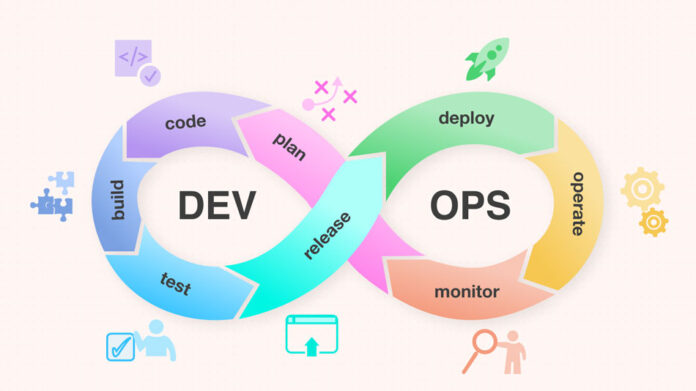Table of Contents
The DevOps approach has become increasingly popular, attracting business owners and developers. It fosters a collaborative relationship between development and operations, enabling agile practices. The DevOps Lifecycle phases involve some crucial aspects for streamlining the development and deployment process. This ongoing software development process incorporates best practices for planning, building, integrating, deploying, monitoring, and continuously providing feedback throughout the development lifecycle. Now, without further ado, let’s dive into our topic and examine the stages included in the DevOps Lifecycle.
Phases of DevOps Lifecycle
The DevOps Lifecycle presents a structured framework that guides projects and outlines the subsequent phases of their DevOps journey. This Lifecycle comprises seven straightforward steps or processes, commonly called the DevOps Lifecycle. These phases empower businesses to develop high-quality projects efficiently, within shorter timeframes, and with enhanced reliability. Now, let’s progress further and explore these phases in detail.
Continuous Development
During the Continuous Development of the DevOps Lifecycle, the team creates and submits code to a version control system such as Git. They receive feedback on their work and make any necessary adjustments. Even after the final release, developers remain actively involved in ongoing modifications, addressing both the backend and front end of the application. This continuous improvement process encompasses all aspects of the application’s development. The tools employed in the Continuous Development phase of the DevOps Lifecycle Phases include GitLab, Git, SVN, Mercurial, and others.
Continuous Integration
Continuous Integration is crucial in the DevOps Lifecycle phases, incorporating new upgrades, functionalities, and additions into the existing codebase. During this phase, errors within the program are detected and identified at each step of the testing process, resulting in simultaneous updates to the source code. This stage transforms integration into a continuous process, where the code is evaluated after every commit. Proper planning and execution of tests within this phase are essential to ensure seamless progress. Some notable DevOps tools for Continuous Integration include Jenkins, Buddy, Bamboo, and Travis.
Continuous Testing
Continuous Testing holds significant importance within the development process as it encompasses sending the code written and integrated by developers to testers. These testers utilize automated tools to identify any bugs or errors in the code. Moreover, this DevOps Lifecycle phase enables the scheduling of tests to run at specific times. Once the testing is finished, a comprehensive report is generated and shared with the developers, highlighting any bugs or errors discovered during the testing phase. After reviewing the report, developers locate and address the issues, making the necessary updates to rectify the code errors. Some prominent tools for Continuous Testing in DevOps include Selenium, TestSigma, and others.
Continuous Monitoring
Continuous monitoring, encompassing the operational aspects, is pivotal in the overall DevOps lifecycle phases. In this phase, vital information regarding software usage is diligently recorded and analyzed to identify trends and areas of concern. Monitoring is often integrated into the operational capabilities of the software application, taking the form of documentation files or generating extensive data about server availability or memory usage. This phase also plays a critical role in ensuring the security and availability of the service. Some well-known DevOps tools for Continuous Monitoring include Nagios, Splunk, ELK Stack, and others.
Continuous Feedback
During the phases of the DevOps Lifecycle, Continuous Feedback plays a vital role in evaluating the impact of each release on user experience. This evaluation is then reported back to the team to improve future releases. Feedback can be gathered in two forms: structured and unstructured. Structured methods include surveys, questionnaires, and focus groups, while unstructured feedback is collected through social media platforms like Twitter and Facebook. This step is essential in enabling the continuous delivery process to release improved application versions. Notable DevOps tools for Continuous Feedback include Pendo, a product analytics tool that helps companies gain insights from customer perspectives.
Continuous Deployment
In the Continuous Deployment segment of the DevOps Lifecycle Phases, the application is deployed on the production server to make it available for the intended use cases. In this, the completed program is released to the operational servers, which makes it a significant part of the DevOps Lifecycle. Continuous Deployment includes configuration management to make the deployment of code on servers accurate and smooth. The containerization tools play a great deal in the deployment process by offering consistency across development, testing, production, and staging systems. This makes the continuous delivery of the new features possible and efficient. The Continuous Deployment Tool involves the AWS CodeDeploy, Octopus Deploy, Vagrant, Chef, Puppet, and others.
Continuous Operations
The concluding phase of the DevOps Lifecycle holds significant importance in reducing scheduled maintenance and planned downtime. Traditionally, developers had to take the server offline for updates, resulting in increased downtime and potential financial costs for the organization. This phase focuses on maximizing uptime by automating application startup and subsequent upgrades. It also mitigates downtime by utilizing container management platforms like Kubernetes and Docker. Notable tools for Continuous Operations include Kubernetes, Swarm, Docker, and others.
Conclusion
As per our assessment, this is the essence of the DevOps lifecycle phases. Undoubtedly, DevOps has introduced a new culture that ensures practical quality standards for software production. The primary goal is to establish continuity and optimize automation processes. If you are a business owner seeking to automate your business processes and enhance web application performance, Hire DevOps engineer from Bacancy and get the experts who can guide you through the various processes of the DevOps Lifecycle.















